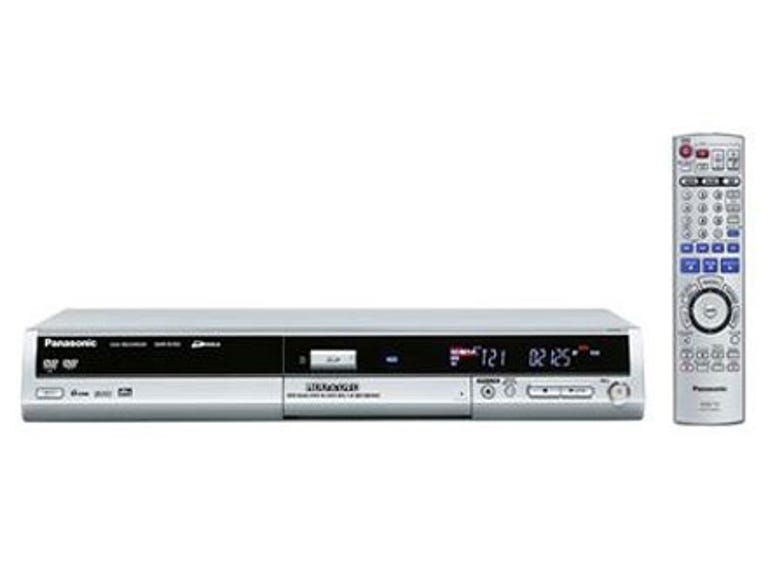 Why You Can Trust CNET
Why You Can Trust CNET Panasonic DMR-EH50 review: Panasonic DMR-EH50
The DMR-EH50 offers exceptional playback and recording options, although some small quirks do detract from the overall package.
Design
Most DVD recorders tend more towards functionality than good looks, and Panasonic's DMR-EH50 has to be commended for at least looking different. This is primarily down to the front panel, which combines a black plastic panel (which incorporates the unit's LED display) running along the top of the unit, slightly offset against the silver panel which houses the main function buttons, as well as a drop-down slot that hides a set of AV connectors. The front panel also includes a flap which hides the DMR-EH50's SD card slot. Our only complaint with this is that it's placed exactly where you'd expect the disc eject button to be -- more than once in our testing we idly jabbed at it to get a disc back, which naturally didn't work out too well. The DMR-EH50 offers four AV inputs, which should be enough for even the most ardent videophile.
The Good
The Bad
The Bottom Line
Like most hard disk based DVD recorders, the DMR-EH50's remote isn't for the timid, as it's a chunky unit with a lot of function buttons on it. One unique feature of the remote is that it features a scroll wheel for rapid picture seeking; that's something we haven't seen a lot of since the days of VHS. In the style of Apple's iPod, it's not just a scroll wheel, however. By clicking in compass directions you can navigate menu options or perform other context-sensitive operations, and the centre of the wheel forms the unit's Enter key. Clearly laid out buttons at the top of the remote switch between hard drive, DVD and SD card playback options.
Features
The hard drive within the DMR-EH50 is an 80GB model, which isn't huge, but should be sufficient for all but the most committed couch potatoes. If you're willing to stretch the limits of the drive and you're not terribly fussy about picture quality, you could cram 142 hours of TV on EH50's 80GB drive (Panasonic also sells an upgrade model, the DMR-EH60 for AU$1099, which has a 200GB hard drive). The time will come when you want to permanently archive material, and here the DMR-EH50 offers a nice little suite of writing options, as it'll record to every DVD recordable format except dual layer discs and DVD+RW. That still gives you the options of DVD-RAM, DVD+/-R and DVD-RW. The DMR-EH50 offers four standard recording modes which give you between 1-8 hours recording onto single sided media, as well as a flexible recording mode that'll adjust data rates to give you the best possible rate based on the amount of space available on a disc. Annoyingly, you've got to select flexible recording from the outset; there's no way to resample recordings at a later date for dubbing purposes.
The DMR-EH50 also boasts what Panasonic calls "1 second quick start recording" to either the hard drive or DVD-RAM media. This is done by quickly hitting record when first powering the unit up, as long as the clock's been set. Panasonic claims better recording quality with the DMR-EH50's Long Play mode (4 hours to a single sided disc) and its progressive scan playback capabilities.
Performance
For the most part we were extremely pleased with the DMR-EH50's operation, although we did hit a few minor quirks and annoyances along the way. Our chief concern was that the internal menu structures of the recorder aren't all that cleanly laid out, and that leads to a lot of initial confusion. Sadly, the manual's not much help here, as while it patiently lists every function of the recorder in a flowchart-like fashion, it's not very easy to read if you're quickly trying to work something out while your favourite program plays in the background.
Recording of programs in multiple quality modes went well, and the DMR-EH50 is capable of dubbing across to disc at the highest speed supported by your media, making backups quick in theory, although here again the menu structures make this a little more choresome than it really should be. You've only got the choice of one layout type for your finalised discs, unlike the superb set of offerings that the Toshiba RD-XS34 offers.
The scroll wheel on the remote is a cute idea, but in actual use we found it a bit clunky and slow to respond. We also hit a problem in some menu functions with it, as there's a natural inclination to hit the enter key to stop track seeking, where in many cases you'll actually want to hit the play button instead. The promised improvements in Long Play recording quality were noticeable, although fast action scenes still displayed plenty of chunky pixellation. That's not that surprising, however, as there's only so far you can squeeze a single layer disc.


